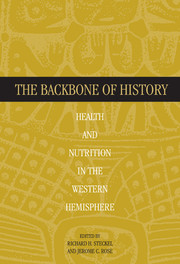Book contents
- Frontmatter
- Contents
- Preface
- List of Contributors
- PART I
- PART II METHODOLOGY
- PART III EURO-AMERICANS AND AFRICAN-AMERICANS IN NORTH AMERICA
- PART IV NATIVE AMERICANS IN CENTRAL AMERICA
- PART V NATIVE AMERICANS AND EURO-AMERICANS IN SOUTH AMERICA
- Introduction
- 12 Patterns of Health and Nutrition in Prehistoric and Historic Ecuador
- 13 Economy, Nutrition, and Disease in Prehistoric Coastal Brazil: A Case Study from the State of Santa Catarina
- PART VI NATIVE AMERICANS IN NORTH AMERICA
- PART VII
- PART VIII
- PART IX EPILOGUE
- Index
12 - Patterns of Health and Nutrition in Prehistoric and Historic Ecuador
Published online by Cambridge University Press: 01 March 2010
- Frontmatter
- Contents
- Preface
- List of Contributors
- PART I
- PART II METHODOLOGY
- PART III EURO-AMERICANS AND AFRICAN-AMERICANS IN NORTH AMERICA
- PART IV NATIVE AMERICANS IN CENTRAL AMERICA
- PART V NATIVE AMERICANS AND EURO-AMERICANS IN SOUTH AMERICA
- Introduction
- 12 Patterns of Health and Nutrition in Prehistoric and Historic Ecuador
- 13 Economy, Nutrition, and Disease in Prehistoric Coastal Brazil: A Case Study from the State of Santa Catarina
- PART VI NATIVE AMERICANS IN NORTH AMERICA
- PART VII
- PART VIII
- PART IX EPILOGUE
- Index
Summary
ABSTRACT
The prehistory and history of health and nutrition in Ecuador are examined from 22 samples of human remains drawn from sites that date from about 6000 bc to ad 1940 and come from diverse ecological environments. The study suggests a deterioration of health and nutrition with the beginnings of agriculture and increased sedentism. It also reveals less evidence of morbidity in prehistoric samples from the highlands compared to the coastal regions. However, within the coastal samples there were variations between the tropical humid north coast and the more arid south coast that related to differences in the natural environment and in the character of societies living there. Apart from the higher frequencies of periosteal lesions and evidence of trauma, generally the north coast samples revealed less evidence of morbidity than those from the south coast. The skeletal evidence reveals little change in health and nutrition following the Spanish Conquest. This may reflect in part the samples available, but also the fact that traumatic events, such as epidemics that are noted in the documentary sources, left no mark on the skeleton. The study suggests that health and nutrition in Ecuador were generally better than in other regions of Latin America, notably Mexico.
Scholars generally agree that when European explorers penetrated the New World it was already occupied by diverse peoples. Scholars also agree that their populations declined as a result of the introduction of new pathogens and the cultural changes brought by colonial rule. However, there is less agreement on the magnitude of the decline and on exactly what new pathogens were introduced, the extent of their impact, and their significance relative to others factors implicated in the decline.
- Type
- Chapter
- Information
- The Backbone of HistoryHealth and Nutrition in the Western Hemisphere, pp. 343 - 375Publisher: Cambridge University PressPrint publication year: 2002
- 22
- Cited by



